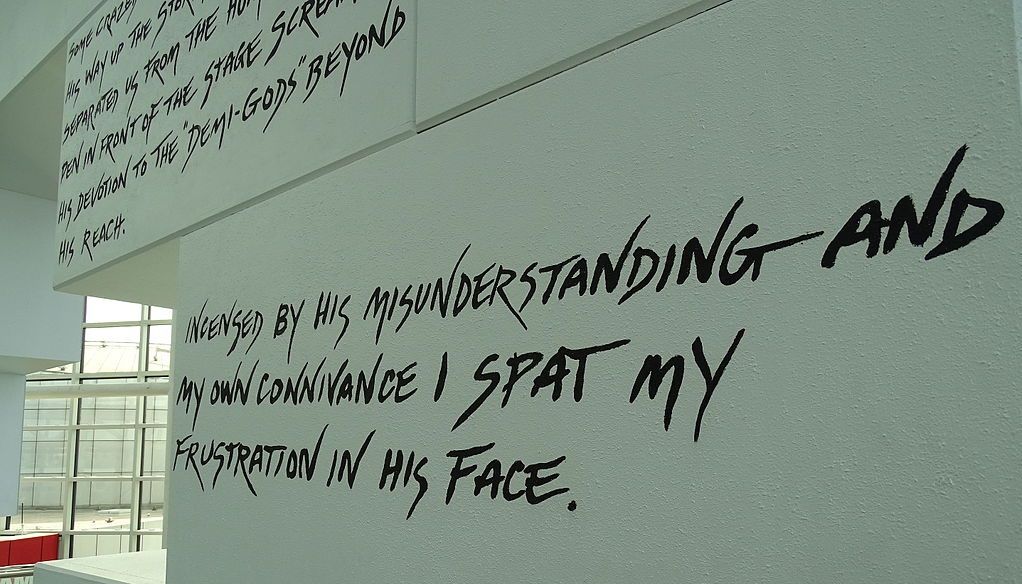Anodyne Comedy: Doug Walker, Roger Waters, and Internet Culture's Superficial Connection to the Past and Ideology

It was as I recall in the form of a scroll, gold leaf and all. And I found it one day in a drawer of old photographs hidden away. And my eyes still grow damp to see good old King George signed it with his own rubber stamp.
Roger Waters, When the Tigers Broke Free
“Hello, I’m the Nostalgia Critic. I remember it so you don’t have to.”
Nostalgia Critic catchphrase
The last two years have not been kind to Channel Awesome, the once mighty online entertainment network. Emerging in the mid-to-late 2000s, Channel Awesome (formerly known as “That Guy with the Glasses”) emerged as a hub for internet critics to host their content on one convenient platform in order to get around the draconian YouTube copyright rules of the era. Doug Walker’s character and show, The Nostalgia Critic served as the centerpiece of Channel Awesome’s content and business model. Around ten years later, Walker would be one of only three creators still associated with his once dominant content network. In 2009 Nostalgia Critic:
averaged 100,000 to 300,000 viewers per week while on the site, and one million page views per month. This was expected to increase following Blip’s deal with YouTube in July 2009. As of July 2009, the site earned more than $10,000 per month in advertising revenue and received more than $11,000 in online donations. In the third quarter of the 2009 fiscal year, Walker’s shows earned $53,000, including $32,000 from Nostalgia Critic [sic] alone.
Trouble began to emerge in mid-2018 when a mass exodus of producers from Channel Awesome began. Through the publication of an omnibus of grievances called “Change the Channel,” numerous complaints of mismanagement and exploitation surfaced against the management of Channel Awesome, particularly its owner, Mike Michaud, and its chief editors, Doug Walker and his brother, Rob. The most egregious complaints included the lack of adequate provisions on set during production of the platform’s “anniversary specials,” injuries occurring on-set of these same specials, the lack of compensation for travel to these specials, and discouraging producers from seeking independent sources of funding on the newly-founded fundraising platform, Patreon. In a response to the creators of the “Change the Channel” document, information emerged that a popular contributor at Channel Awesome, Justin “Jew Wario” Carmichael, was forced to resign from the site following undisclosed allegations of sexually “grooming” underaged fans (the barely visible top of a “J” in a blacked out part of a document tipped net-savvy followers of the feud off on Carmichael’s identity). Carmichael committed suicide in 2014.
“Change the Channel” damaged Channel Awesome’s brand and undisputed status as the repository of internet reviews, but did not completely sink Walker’s popularity as a content creator. Channel Awesome’s YouTube channel still possesses over a million subscribers and publishes new episodes of the Nostalgia Critic weekly. However, in an act that befuddles Walker’s fans, late September saw the release of a Nostalgic Critic review of Pink Floyd The Wall. The 1982 film adaptation of the beloved Pink Floyd album of the same name, while not an undisputed classic of cinema, possesses a very devoted cult following owing to the film’s status as a “midnight movie.”
Walker, enlisting the talents of Slipknot’s Corey Taylor and the Chicago-based guitarist, Rob Scallon, created a parody of Pink Floyd’s album and used it as the soundtrack of the review, which parodies the film adaptation. Further, Walker released this soundtrack as a standalone album on streaming services under the Nostalgia Critic moniker. The reception to Walker’s 42 minute parody has been overwhelmingly negative. Currently, the album resides as the number one worst ranked album of 2019 and all time on the music review site, RateYourMusic, beating out other legendarily bad albums such as Corey Feldman’s Angelic 2 the Core and both Crazy Frog compilations. The self-proclaimed “internet’s busiest music nerd,” Anthony Fantano included the album in his series of “Not Good” albums. Further, the JAR media podcast, featuring the English YouTube critic, “I Hate Everything,” harshly criticized Walker’s treatment of The Wall as pedantic and confused, missing the point of Pink Floyd’s rock opera.
Indeed, Walker’s treatment of Pink Floyd and Roger Waters’s The Wall does possess many glaring flaws. Among one of the oft-commented ones is Walker’s insistence that The Wall and its legendary lead single, “Another Brick in the Wall, Pt. 2” represents a type of whining about “high-school” and that the song itself is anti-education and shallow. JAR pointed out that the song details the extremely sordid and authoritarian state of English education in the 1950s and 60s (around when Roger Waters attended primary school) really was that bad and traumatic for a generation of people who came of age to Pink Floyd’s music.
JAR is correct, but this particular criticism of Walker’s reveals a flaw not only with Walker’s brand of 1980s-stand-up sense-of-humor, but with the modern internet’s connection with the past and ideology. To Walker, Waters’ whole project—from his opining about his father’s death in Anzio in the Second World War to his criticism of the English education system to his disdain for modern arena rock in the Thatcher era – is pretentious whinging about the past. Waters, as a successful rockstar, should “grow a pair,” as Walker sings over the Floyd song, “Goodbye Blue Sky.” In other words, individual success as measured in fans, record sales, and advancements should nullify the pains of living through the 20th century.
Scars of the 20th century
The Wall is an ambitious rock opera detailing the mental decline of “Pink,” a rockstar based on Waters himself and former Pink Floyd member Syd Barrett, whose own decline into schizophrenia following the band’s 1967 debut album forms the stuff of rock legends. Yet, as Walker points out, this decline includes a major criticism of Thatcher’s Britain. Indeed, as Pink declines and isolates himself from others, especially his wife and friends, he assumes a more blatantly authoritarian persona, eventually culminating in the infamous Nazi imagery found in the second part of the album and film.
However, this descent is a slow burn and it begins early in the project. “Another Brick in the Wall, Pt. 2” is a mainstay of classic rock radio and its refrain “Hey! Teacher! Leave those kids alone!” is a popular rallying cry among students, disdainful of the small indignities of student life. On another iconic line, “We don’t need no education,” Walker makes the obvious joke: “Well, that’s a double negative, so clearly, they do need some education.” The line represents Pink’s “building” of the wall – questioning the very efficacy of public education itself, giving himself over to the forces of British neoliberalism. “We don’t need no education” is the first step in Pink accepting the now-infamous Thatcherite line, “There is no such thing as society. There are only individuals and families.”
As the concept develops Pink’s “wall” between himself and society grows taller, as the film’s animations depict the titular wall destroying churches, turning babies into fascists, and flowers into barbed wire. In a word, the same English society that Pink’s father gave his life defending has crumbled away, creating a vast chasm between artist and audience, citizen and state, and one’s self and the other. The second half’s fascist imagery resembles the short-lived “blackshirts” of Oswald Mosley’s British Union of Fascists more than it does the Nazis, suggesting the sacrifices made by English society during World War II and the blitz have failed to conquer England’s own demons, prompting a return to a decidedly English form of fascism.
The critique
Curiously, Walker has his own spin on the infamous Nazi imagery in The Wall. Appearing in the black shirt Bob Geldof dons in the film, Walker paints the words “person that you hate” on his face. He draws attention to Waters’s intended target (Thatcher), but then says that the figure of Nazi Pink represents “whoever the audience hates at the time.” He then implicates the presence of social media and “cancel culture” as a form of modern authoritarianism and then flashes a variant of the “hammer” hand sign from the film as a “hashtag” sign. Then, an animation riffing on Gerald Scarfe’s famous sequence of goose-step hammers from the film plays, only displaying goose-stepping phones instead of hammers.
One cannot help but connect this awkward attempt at satire during Walker’s review to his feud with his former Channel Awesome affiliates. Much of “Change the Channel” played out on social media, especially on Twitter (the one with hashtags). While Waters’s use of fascist imagery in The Wall was indeed overblown and one of the least successful visual motifs of the both the film and album (an opinion the rock critic and linguist George Starostin ably defends in his review of the album), it at least made a larger societal point beyond Waters’s own sense of alienation. Here, Walker succumbs to the artistic excesses he identifies in Waters: substituting one’s own problems and misgivings about success for a societal critique.
While Walker no longer reigns as the undisputed king of telling jokes over other people’s movies, his web presence and fan base is still commendable. However, one gets a sense of entitlement creeping from subtext to text in Walker’s rant against social media: he is the victim of the online mob’s ire and transfers that sense of victimhood into a thinly-veiled “parody” of one of Pink Floyd’s most politically incendiary albums. At least Roger Waters named names. There are definitive targets of his artistic rage: arena rock, neocolonial war, neoliberalism, and institutional abuse. Walker, meanwhile, remains intentionally vague, using tropes of “anti-SJW” discourse like “twitter mob” and “social media” to make a point about social media so aimless and hackneyed one wonders why it was included at all. And, while Waters sustains his criticism of these targets, albeit imperfectly, throughout The Wall, Walker’s criticism of social media lasts the length of The Wall’s songs “In the Flesh” and “Waiting for the Worms” and then does not return.
There are, indeed, very good reasons to possess skepticism about so-called “cancel culture” and social media’s nearly ubiquitous place in society. But there are also good reasons to oppose Thatcherism and its subsequent period of privatization and austerity in English society. Doug Walker, however, does not possess the moral authority necessary to make such bold claims regarding the nature of “cancel culture,” considering Walker’s own silence in response to his critics’s complaints about his management style that lead to the “Change the Channel” debacle. It is especially difficult to take seriously after he spends half an hour of film calling Roger Waters pretentious for complaining about the direction of society in spite of his good fortune.
The Wall is one of the best-selling and beloved albums of all time. However, its success represented the destruction of Pink Floyd in its most famous iteration. During the album’s recording, Waters fired long-time, founding member Richard Wright. Waters then left the band in the mid-80s, prompting an extremely tense legal battle with his former bandmates David Gilmour and Nick Mason over the use of the name “Pink Floyd.” Ironically, Doug Walker’s The Wall is inconceivable without the prior dissolution of Channel Awesome. Unlike Pink Floyd, Channel Awesome does not have a legacy of work that has stood the test of time on which to lean. Instead, Channel Awesome’s laurels rest on a history of forgotten memes, easy jokes, and hammy comedy. And, its legacy resides in the thoroughly corporatized vision of “criticism” seen in the pedantry of Cinema Sins and Screen Junkies.
To quote the legendary Pink Floyd song, “Wish You Were Here,” “Did you exchange a walk-on part in a war for a lead role in a cage?” Waters’s metaphor can be reversed here: Walker exchanged a lead role in a war for a walk-on part in a cage. The war being the “Change the Channel” dispute, which while resulting in the loss of most of Walker’s channel partners, allowed him to continue his presence on YouTube. However, Walker now finds himself imprisoned by the YouTube algorithm, destined to produce content that amuses, but does not inspire.
Featured image is Detail of Roger Waters Quote from Pink Floyd The Wall Exhibit, by Adam Jones




